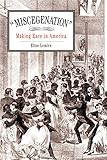"Miscegenation" : Making Race in America / Elise Lemire.
Material type: TextPublisher: Philadelphia : University of Pennsylvania Press, [2010]Copyright date: ©2002Description: 1 online resource (216 p.) : 19 illusContent type:
TextPublisher: Philadelphia : University of Pennsylvania Press, [2010]Copyright date: ©2002Description: 1 online resource (216 p.) : 19 illusContent type: - 9780812220643
- 9780812200348
- American literature -- 19th century -- History and criticism
- Literature and society -- United States -- History -- 19th century
- Miscegenation in literature
- Racially mixed people in literature
- Literature
- LITERARY CRITICISM / American / General
- African Studies
- African-American Studies
- American History
- American Studies
- Cultural Studies
- Literature
- 810.9/355 21
- PS217.M57 L46 2002eb
- online - DeGruyter
- Issued also in print.
| Item type | Current library | Call number | URL | Status | Notes | Barcode | |
|---|---|---|---|---|---|---|---|
 eBook
eBook
|
Biblioteca "Angelicum" Pont. Univ. S.Tommaso d'Aquino Nuvola online | online - DeGruyter (Browse shelf(Opens below)) | Online access | Not for loan (Accesso limitato) | Accesso per gli utenti autorizzati / Access for authorized users | (dgr)9780812200348 |
Frontmatter -- Contents -- Illustrations -- Introduction: The Rhetorical Wedge Between Preference and Prejudice -- 1. Race and the Idea of Preference in the New Republic -- 2. The Rhetoric of Blood and Mixture -- 3. The Barrier of Good Taste -- 4. Combating Abolitionism with the Species Argument -- 5. Making "Miscegenation" -- Epilogue: "Miscegenation" Today -- Notes -- Bibliography -- Index -- Acknowledgments
restricted access online access with authorization star
http://purl.org/coar/access_right/c_16ec
In the years between the Revolution and the Civil War, as the question of black political rights was debated more and more vociferously, descriptions and pictorial representations of whites coupling with blacks proliferated in the North. Novelists, short-story writers, poets, journalists, and political cartoonists imagined that political equality would be followed by widespread inter-racial sex and marriage. Legally possible yet socially unthinkable, this "amalgamation" of the races would manifest itself in the perverse union of "whites" with "blacks," the latter figured as ugly, animal-like, and foul-smelling. In Miscegenation, Elise Lemire reads these literary and visual depictions for what they can tell us about the connection between the racialization of desire and the social construction of race.Previous studies of the prohibition of interracial sex and marriage in the U.S. have focused on either the slave South or the post-Reconstruction period. Looking instead to the North, and to such texts as the Federalist poetry about Thomas Jefferson and Sally Hemings, James Fenimore Cooper's Last of the Mohicans, Edgar Allan Poe's "Murders in the Rue Morgue," and the 1863 pamphlet in which the word "miscegenation" was first used, Lemire examines the steps by which whiteness became a sexual category and same-race desire came to seem a biological imperative.
Issued also in print.
Mode of access: Internet via World Wide Web.
In English.
Description based on online resource; title from PDF title page (publisher's Web site, viewed 24. Apr 2022)


